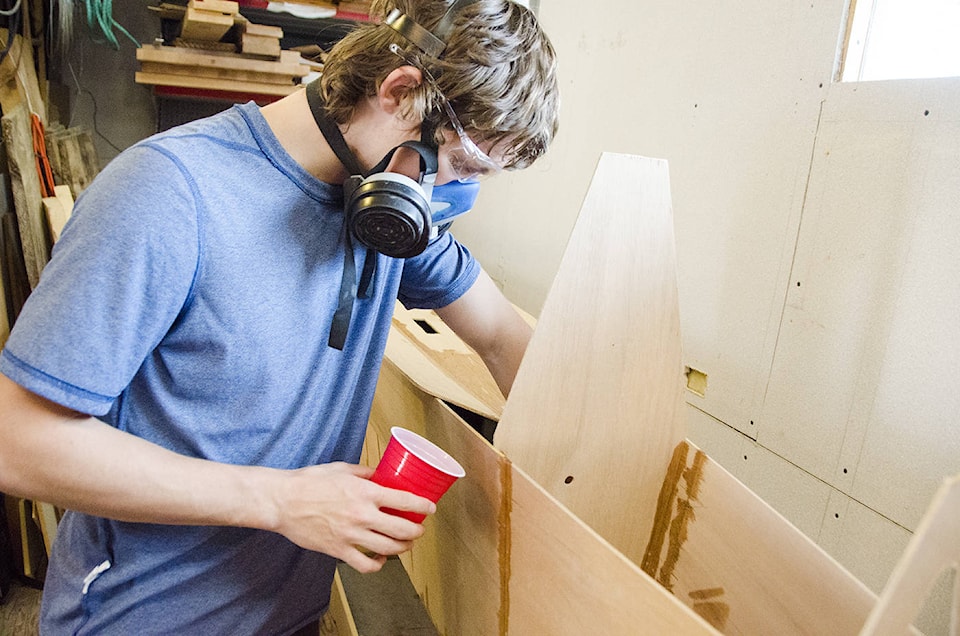Despite coming from a water-loving family, Carihi student Quinn Kuschel-Ross hasn’t always been such a huge fan.
You might not guess that when you talk to him about how he’s building his own one-man hydrofoil sailboat in his shed.
“When I was a kid I’d go out with my dad and my grandpa, and I didn’t care for it. It was pretty scary with all the waves and it was leaning over and it was tippy, you know?” he says with a laugh. “But when I took the nautical program at Carihi it totally changed my perspective.”
Unfortunately, the nautical program has been canceled for the upcoming year.
“I still really wanted to do something boat related,” he says, “and remembered being told about IDS – independently directed studies – and since I’d been stuck on this hydrofoil boat I saw in a book a while back and I wanted to do something hands-on, I decided, ‘why not build one?’”
The course involves a whole lot of research, a whole lot of troubleshooting, a whole lot of consultation with industry experts, and many, many late nights out in the shed.
And he’s barely begun.
“I found one set of plans online,” he says. “Well, it wasn’t really plans, it was a set of dimensions for how to cut $3,000-$4,000 carbonfibre panels to build the hull, and, yeah, that wasn’t something I was about to try to do for a school project. So I went to Nautech Industries in Courtenay and they told me to build a plug, which is the same shape as the hull, and I can use that to make a mold, which I can then use to make the hull.”
So he used the dimensions he found online, made a jig out of plywood to construct pieces to make the plug, which he will then use to make a mold out of fibreglass, which he will then use to make the hull out of carbon fibre.
“The carbon fibre cloth I’ll be putting in the mold is about one-tenth the cost of the panels, so this way is way cheaper.”
He’s thinking he can get the cost of the hull down to between $600 and $1,000 by doing it his way, with the entire cost of the vessel coming in around $3,000 or $4,000 – a fraction of the $20,000 price tag of purchasing one.
“I’m hoping to have it done by the time I graduate, but I’m not too worried about it if I don’t. If I rush it, it won’t turn out well. So I’m taking my time and making sure I know what I’m doing before I do it so that I end up with the boat I want.”
He’s also documenting the entire process on video – for three reasons.
The first is that because he’s doing it at home in his shed, he needs to prove to the school that he’s doing the work in order to get the credit for the project. Secondly – and more importantly – he says, is that he wants to be helpful.
“It was so hard to find any information out there about how to do this,” he says. “I did over 60 hours of scouring the Internet and found pretty much nothing. There are tons and tons of videos and tutorials out there of people making everything else you could imagine, but for some reason, there isn’t any on making a moth-class sailboat, so I thought, ‘I want to make this easier for people to do and let them learn along with me. I want to be a resource.’”
The third reason is more pragmatic.
“If I want anyone to sponsor me and help me do this, it will be a lot easier if I can show them what I’m talking about rather than just trying to explain it,” he says. Right now, he’s looking for financial help to buy supplies, so if you have anything he might be able to make use of, send him an email at buildingcecropia@gmail.com.
He’s also always looking to develop the skills that will help him in his build, so if you have any expertise in boat building or manufacturing methods and would be willing to share, he’s asking for you to contact him, as well.
“My hope is that I can maybe put some banners up in the background of the videos and get some stickers on the hull once it’s done to show off the people who have been helping me and thank them however I can, because I really appreciate all of the help I’m getting in this,” Kuschel-Ross says.
More than anything else, Kuschel-Ross says he hopes his experience will encourage more kids to take on independently directed studies classes in things they’re into.
“It’s not very well advertised,” he says. “And it’s definitely not for everyone, but it would be nice if the teachers saw that someone is really into something and they have the drive to do it, this could be something they could suggest. For me, because this is something I love, it’s ideal.”
You can follow Kuschel-Ross along on his boat-building adventure on YouTube here.
